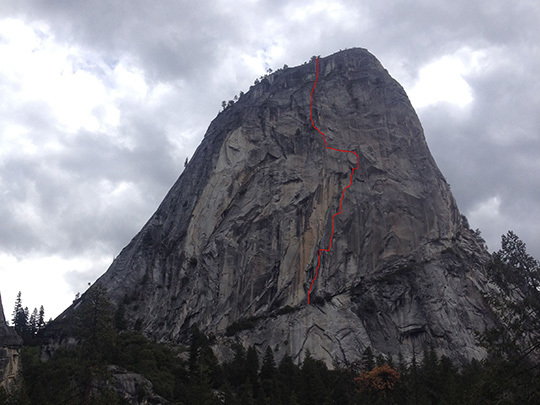
The walls of Yosemite Valley have been scoured for unclimbed lines. To hopeful first ascentionists, it can seem that every inch of rock has already been touched. The Golden Age of climbing in Yosemite may have come and gone, but last week, Lucho Rivera and Cedar Wright proved there are still puzzles waiting to be unlocked by creative minds. On May 31, they established the first free route on the southwest face of Liberty Cap, a 16-pitch link-up of old aid routes they’ve tentatively named Mantah (IV 5.12d/5.13a, 1,100′).
Following in the 44-year-old footsteps of Joe Faint, Warren “Batso” Harding and Galen Rowell, Rivera and Wright free climbed Pitch 1 and Pitch 2 of the original Southwest Face route (V 5.8 C2). Pitch 3 to Pitch 7 linked into Bad Moon Rising (VI 5.8 A2), an impressive aid line established last year by Ezra Allen, Steve Bosque and Josh Mucci. Choosing the most logical free-climbing terrain, they continued through unclimbed ground before arriving at the roof pitch on the Direct Southwest Face (VI 5.10 A5). From the roof they traversed back to Bad Moon Rising and into the Crack of God, a finger crack that runs dead horizontal for 180 feet. Poking fun, Wright gave the pitch an “athletic 5.9+” grade. The remainder of the climbing overlapped up the Southwest Face route, aside from minor free-climbing variations.
I caught up with Wright between sips of coffee to hear more about what he calls “one of the best free climbs in Yosemite Valley”:
What turned your attention to free climbing Liberty Cap’s southwest face? What kind of history is there?
Our line on the southwest face was the first free route on that aspect. There are nine routes up there currently, but all aid lines. Several of them are kind of new-school routes. Josh Mucci put up a few of them within the last four or five years with assorted partners. We had been looking at [possible free lines on Liberty Cap]. In fact, at one point we tried to climb Liberty Cap via a different aspect. We made good progress until Lucho broke his collarbone and we lost sight of it.
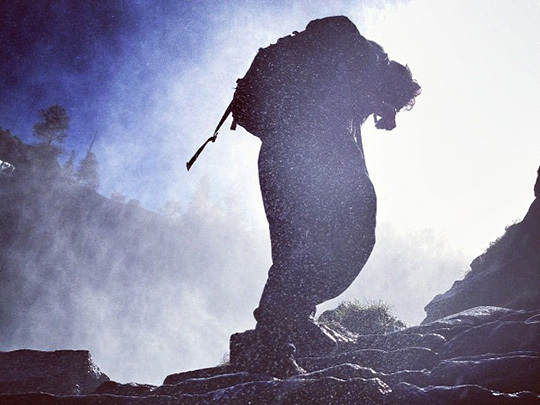
This year we decided that we wanted to do a first ascent in the Valley, so we started throwing around different ideas. Lucho showed me a little write-up that Josh Mucci wrote for the American Alpine Journal about his Bad Moon Rising route. It even mentions it would totally make an amazing free climb. You know, “Free climbers come up here and send this thing.” I was shown some photos of the face and after looking at it I was like, “Man, this is amazing.” Mucci’s route turned out to be the way to free climb the southwest face. The Harding route, it’s nice to look at and everything, but there’s a bolt ladder that would just never go free.
Was this the first year that you guys tried to free the route?
Yeah, so about two months ago we put some work in on it and then my schedule got a little more hectic, so I left Yosemite several times for work-related stuff. We calculated it, and I think we put maybe 14 days of effort into the route. First we aid climbed up it and fixed lines. Then we cleaned all of the rock for free climbing. There was some dirt in cracks and stuff like that, because the route, Bad Moon Rising , had only seen one ascent from the year before. The corner pitches required a lot of cleaning. Then we just started working on free climbing with Mini Traxions. Once we linked all the sections, we went for it and miraculously pulled it off.
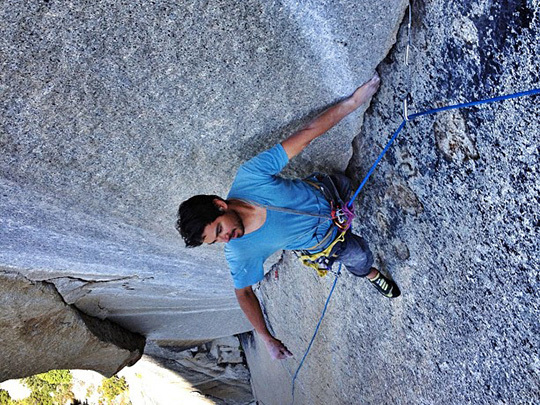
So was it a one day push?
Yeah, we redpointed it in a day. I ended up leading the center crux sections of the route. Lucho also climbed everything free so it became a free ascent.
Can you take me through the route pitch by pitch?
You kick things off by climbing the first two pitches of Harding’s route: a 5.11R pitch into a spectacular hand 5.10 pitch. Then you traverse on new ground to a ledge system that gets you to the Bad Moon Rising route. Mucci and his partners came directly up using copper heads and bolts to get to this point. From there we followed Harding’s route. This is where the real climbing began. The next four pitches are 5.12, and they get progressively harder. A lot of laybacking and some tricky stemming get you to what is called the Peregrine Fly Pitch, which for me was the most difficult pitch. We’re saying this pitch is something like 1980s 5.12c or modern 5.13a [laughs]. After the Peregrine Fly Pitch, Bad Moon Rising goes left and our fifth 5.12 pitch in a row veers right and up a cool layback, stemming flake, then traverses out to a huge roof that you can see from down on the ground. One of the redpoint cruxes is doing the fifth pitch of 5.12+ in a row. The last pitch is quite gymnastic, pumpy and tricky to read because it traverses out a roof and goes up a strenuous, layback. We spent a lot of time thinking about that and how to lead it. You climb up a crack, then into a roof, go down the roof, then traverse out of the roof. So the way the rope runs is weird. We eventually figured out how to make it work, but it was a tremendous amount of effort on both of our parts.
Long story short, after traversing out of the roof, it takes you to the Crack of God Pitch. They called it the Crack of God because Ezra Allen, Steve Bosue and Josh Mucci had gotten up eight or nine pitches and were looking up at a blank face, but there was this finger crack going dead horizontal for 180 feet. We came in fifty feet right of the crack and climbed the entire thing. It has to be one of the most unique, crazy pitches I’ve ever climbed, and at that point you’re above Nevada Falls, and it’s just booming while you campus across this wild finger crack. It’s pretty amazing. The Crack of God Pitch is definitely one of the coolest pitches in Yosemite Valley.
Then you get back on Harding’s route, and you have some 1980s 5.11 climbing to do, like hard 5.11–could even be 5.12 Indian Creek-type climbing. Then you have a really high-quality corner, boulder problem to one final 5.12 pitch. It’s a very technical, crimpy, slab-style section. It feels really hard at that point in the day, after you’ve done a lot of hard climbing.
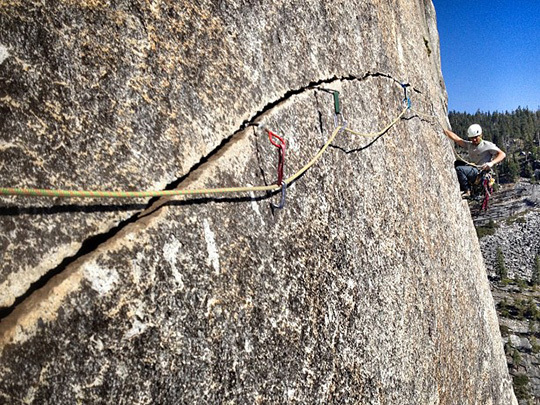
A few more pitches of old school 5.8 and another 5.10 pitch bring you to the final pitch that required Harding and his partners to spend another night on the face in 1969. The final 5.8 pitch is probably the hardest 5.8 pitch I’ve ever done. I was surprised at how hard it was [laughs]. It is not over until you you climb it to the summit, I swear to God. Lucho and I were like, “Wow, 5.8?” It’s kind of scary.
Yeah, I know all about it. Climbing here in the Northeast–I’m in Vermont–so I visit Cannon frequently. There are death blocks all over the place with runout pitches put up back in the day by the likes of Rick Wilcox, John Bragg and a few other hardmen. There are a lot of old school climbing routes up there.
So how does this compare to some of the other routes you’ve put up around the world?
Well, it’s hands down the best free route I’ve ever established in my life, and I’ve established some incredible routes. Lucho and I did Dragon Horns in Malaysia–That was world-class incredible, but this is even better than that. I don’t think I’m running off my own high when I say that this is one of the best free climbs in Yosemite Valley. Every single pitch is amazing. The rock is impeccable, everything about it is great. And the fact that the Nevada Falls is down there booming away just adds to the route. It just has an amazing ambiance and it is spectacular. I would say it’s a modern day classic. The fact that we were able to climb one of the last major routes in Yosemite Valley that hadn’t been freed is kind of like a dream come true. I’m totally on cloud nine about it. I feel like we got so lucky.
Were there any intense moments?
Well, for me, it was every pitch. Just climbing every hard pitch in a row was heinous. Before I would continue climbing I was just like, “Oh, I hope I can do it.” The roof pitch was definitely my moment of truth because I was really about to fall the whole time. If I had fallen off that pitch then it could have fallen apart for us, especially because we were squeezing the route in before the summer heat came. We had managed to climb in the shade at that point, but if I had fallen, we would have been in the direct sun for the next burn, that would have been really tough. When Lucho and I finished that pitch we were both nauseous and pumped. I couldn’t have done a pull-up to save my life. I was like, “Thank God we did it first try.”
From there is was just about hanging onto the rock until that last 5.12 slab pitch. I whipped off of it twice before I sent it, so that was really stressful. Here I am, the last crux pitch and I was so tired. At that point it was the middle of the day and so hot. It’s probably the scariest pitch of the climb, too. You clip this aid bolt and then you pretty much just climb. Aid climbers place pitons and really small cams in this arching crack, but if you’re free climbing there’s no way to place any gear, so you punch it for about 15, 20 feet. It would be a really big fall if you blew it. Luckily I fell low on the pitch, and once I got to the runout I managed to punch through it.
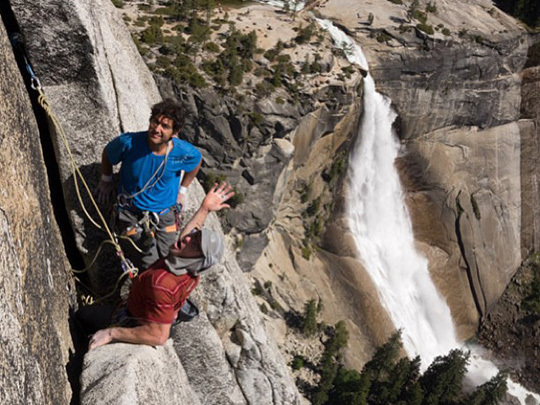
Do you think it will get traffic?
I’m on a mission to get people up there now. This route deserves repeats. I’m definitely going to get all my Valley hardman friends to get up there. It’s probably a little late in the season, so I’ll try to get them up there this fall to avoid the heat, but I definitely want to get Honnold up there and get some of my other local hardman buddies on.
So tell us a little bit about your partnership with Lucho. When did you guys first meet?
I first met Lucho in Yosemite Valley probably around 1999 or 2000. I was working on this incredible 5.13 roof crack and running out of belayers. So I met Lucho basically because I was looking for a belayer, and he was psyched. He was really supportive of that mission. He came up there and even though he was basically a 5.11 climber, got on it and dangled around. He learned a lot and was really psyched on being part of a first ascent. We went on to do a lot of routes together. About eight years ago, we climbed Camp 4 Terrorist (V 5.12b) on the Camp Four wall together. We’ve done several routes in the Sierras and, most recently, we climbed in Malaysia together. I just feel so lucky. I feel like I’m putting up these ultra-classic free routes, like modern day classics that should have been done in the 80s. I guess nobody got around to them.
Wright’s next project: He and Alex Honnold will attempt to climb all the 14,000′ peaks in California using only bicycles as transportation. They’ll be starting off with Mt. Shasta and continue south to the Sierras.